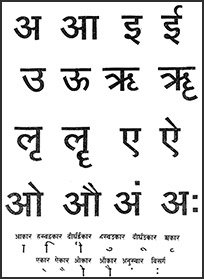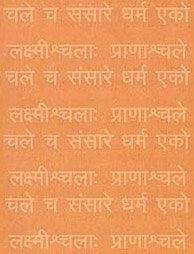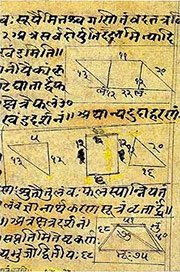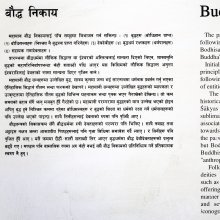Krama: 26 definitions
Introduction:
Krama means something in Buddhism, Pali, Hinduism, Sanskrit, Marathi, Hindi. If you want to know the exact meaning, history, etymology or English translation of this term then check out the descriptions on this page. Add your comment or reference to a book if you want to contribute to this summary article.
Images (photo gallery)
In Hinduism
Purana and Itihasa (epic history)
Source: Cologne Digital Sanskrit Dictionaries: The Purana IndexKrama (क्रम).—One of the ten branches of the Sukarmaṇa group of devas.*
- * Brahmāṇḍa-purāṇa IV. 1. 88; Vāyu-purāṇa 100. 93.

The Purana (पुराण, purāṇas) refers to Sanskrit literature preserving ancient India’s vast cultural history, including historical legends, religious ceremonies, various arts and sciences. The eighteen mahapuranas total over 400,000 shlokas (metrical couplets) and date to at least several centuries BCE.
Natyashastra (theatrics and dramaturgy)
Source: Wisdom Library: Nāṭya-śāstra1) Krama (क्रम, “progress”) refers to ‘employment of progressive similes’ to obtain knowledge of another person’s sentiments. Krama represents one of the thirteen garbhasandhi, according to the Nāṭyaśāstra chapter 21. Garbhasandhi refers to the “segments (sandhi) of the development part (garbha)” and represents one of the five segments of the plot (itivṛtta or vastu) of a dramatic composition (nāṭaka).
(Description): “foreseeing of what is coming afterwards, is called progress (krama)”.
2) Krama (क्रम) refers to one of the thirty-three alaṃkāras (embellishments), according to the Nāṭyaśāstra chapter 29. These alaṃkāras, or, ‘embellishments of song’, depend upon the four types of varṇas, which refers to a specific order of musical notes (svara). They are attached to the songs of seven forms, although not generally used in the dhruvās.
According to the Nāṭyaśāstra, “krama is when successive kalās include one two, three; four, five, six, seven consecutive notes which ascend”.

Natyashastra (नाट्यशास्त्र, nāṭyaśāstra) refers to both the ancient Indian tradition (shastra) of performing arts, (natya—theatrics, drama, dance, music), as well as the name of a Sanskrit work dealing with these subjects. It also teaches the rules for composing Dramatic plays (nataka), construction and performance of Theater, and Poetic works (kavya).
Shaivism (Shaiva philosophy)
Source: Google Books: The Krama Tantricism of KashmirKrama (क्रम).—A system of Śaiva philosophy in its own right.—While sharing much in common with the Pratyabhijñā and Kula systems of Kashmir Śaiva monoism, the Krama system has much of its own to justify its recognition as an independent system of philosophy. Historically as well, Krama has been regarded as an independent system. Maṅkha in his Śrīkaṇṭhacarita mentions Mahānaya, another name of Krama, as a distinct philosophical school where the act of creation follows that of withdrawal, implying that the Krama system ardently adheres to the cyclic notion of Reality. This allusion to Krama in a literary work of the eleventh century is a sufficient proof of the popularity of the Krama school, even beyond the philosophical circles.
While all other systems including the Kula, Pratyabhijñā and Trika of Kashmir Śaivism are Śiva-oriented, the Krama is Śakti-oriented. The Krama is more closely connected with the immanent reality and interprets immanence as an essential expression of transcendence. Against this, the Pratyabhijñā and Kula systems are immediately concerned with reality as unity (abheda) or the transcendental aspect of Reality.
Kṣemarāja takes the word Krama to stand for the succession of the cyclic consciousness iof emanation (sṛṣṭi), sustenance (sthiti) and withdrawal (saṃhṛti). While explaining the words “krama-mudrā” and “mudrā-krama” from the Krama-sūtras he also defines the word Krama in the context of the system. According to him, it is called Krama because it (i) causes emanation etc. to appear in succession (Krama) and (ii) itself constitutes the very nature of that (as well as their) successive appearance. Hence Krama is the system that deals with such a phenomenon exclusively, all other aspects remaining subordinate to it.
Source: Brill: Śaivism and the Tantric Traditions (philosophy)Krama (क्रम) refers to the “method” (e.g., ‘the method of tarka’), according to Cakradhara’s Granthibhaṅga, vol. I, 17.—Accordingly, “Through the method (krama) of tarka, something is demonstrated for the opponent exactly as it was understood by oneself at the time of an inference for oneself, because a debate is a discourse of [people] who are free of bias”

Shaiva (शैव, śaiva) or Shaivism (śaivism) represents a tradition of Hinduism worshiping Shiva as the supreme being. Closely related to Shaktism, Shaiva literature includes a range of scriptures, including Tantras, while the root of this tradition may be traced back to the ancient Vedas.
Vyakarana (Sanskrit grammar)
Source: Wikisource: A dictionary of Sanskrit grammarKrama (क्रम).—(l) serial order or succession as contrasted with यौगपद्य (yaugapadya) or simultaneity. The difference between क्रम (krama) and यौगपद्य (yaugapadya) is given by भर्तृहरि (bhartṛhari) in the line क्रमे विभिद्यते रूपं यौगपद्ये न भिद्यते (krame vibhidyate rūpaṃ yaugapadye na bhidyate) Vāk. Pad. II. 470. In order to form a word by the application of several rules of grammar, a particular order is generally followed in accordance with the general principle laid down in the Paribhāṣā पूर्वपरनित्यान्तरङ्गापवादानामुत्तरोत्तरं बलीयः (pūrvaparanityāntaraṅgāpavādānāmuttarottaraṃ balīyaḥ), as also according to what is stated in the sūtras असिद्धवदत्राभात्, पूर्वत्रासिद्धम् (asiddhavadatrābhāt, pūrvatrāsiddham) etc. (2) succession, or being placed after, specifically with reference to indeclinables like एव, च (eva, ca) etc. which are placed after a noun with which they are connected. When an indecinable is not so connected, it is called भिन्नक्रम (bhinnakrama); cf. परिपन्थं च तिष्ठति (paripanthaṃ ca tiṣṭhati) (P.IV. 4.36), चकारो भिन्नक्रमः प्रत्ययार्थं समुच्चिनोति (cakāro bhinnakramaḥ pratyayārthaṃ samuccinoti), Kāś. on P. IV. 4.36; also ईडजनोर्ध्वे च । चशब्दो भिन्नक्रमः ईशेः (īḍajanordhve ca | caśabdo bhinnakramaḥ īśeḥ) (VII.2.77) अनुकर्षणार्थो विज्ञायते (anukarṣaṇārtho vijñāyate) Kāś. on P.IV.2.78; (3) succession of the same consonant brought about; doubling; reduplication; क्रम (krama) is used in this way in the Ṛk Prātiśākhya as a synonym of dvitva prescribed by Pāṇini; e. g. आ त्वा रथं (ā tvā rathaṃ) becomes आ त्त्वा रथम् (ā ttvā ratham) ; सोमानं स्वरणम् (somānaṃ svaraṇam) becomes सोमानं स्स्वरणम् (somānaṃ ssvaraṇam) ; cf. स्वरानुस्वारोपहितो द्विरुच्यते संयोगादिः स क्रमो (svarānusvāropahito dvirucyate saṃyogādiḥ sa kramo)Sविक्रमे सन् । (vikrame san |) etc, R. Pr. VI. l to 4; cf. also स एष द्विर्भावरूपो विधिः क्रमसंज्ञो वेदितव्यः (sa eṣa dvirbhāvarūpo vidhiḥ kramasaṃjño veditavyaḥ) Uvvaṭa on R. Pr. VI. 1. The root क्रम् (kram) IA. is several times used in the Prātiśākhya works for द्विर्भवन (dvirbhavana), cf. also T. Pr.XXI.5; XXIV.5; (4) repetition of a word in the recital of Vedic passages, the recital by such a repetition being called क्रमपाठ (kramapāṭha), which is learnt and taught with a view to understanding the original forms of words combined in the Saṃhitā by euphonic rules, substitution of letters such as that of ण् (ṇ) for न् (n), or of ष् (ṣ) for स् (s), as also the separate words of a compound word (सामासिकशब्द (sāmāsikaśabda)); e. g. पर्जन्याय प्र । प्र गायत । गायत दिवः । दिव-स्पुत्राय । पुत्राय मीळ्हुषे । मीळ्हुषे इति मीळ्हुषे । (parjanyāya pra | pra gāyata | gāyata divaḥ | diva-sputrāya | putrāya mīḷhuṣe | mīḷhuṣe iti mīḷhuṣe |) cf. क्रमो द्वाभ्यामतिक्रम्य् प्रत्यादायो-त्तरं तयोः उत्तेरेणोपसंदध्यात् तथार्द्धर्चं समापयेत् ॥ (kramo dvābhyāmatikramy pratyādāyo-ttaraṃ tayoḥ uttereṇopasaṃdadhyāt tathārddharcaṃ samāpayet ||) R. Pr. X. 1. For details and special features, cf. R. Pr. ch. X and XI: cf. also V. Pr. IV. 182-190: T. Pr, XXIII. 20, XXIV. 6.

Vyakarana (व्याकरण, vyākaraṇa) refers to Sanskrit grammar and represents one of the six additional sciences (vedanga) to be studied along with the Vedas. Vyakarana concerns itself with the rules of Sanskrit grammar and linguistic analysis in order to establish the correct context of words and sentences.
Jyotisha (astronomy and astrology)
Source: Wikibooks (hi): Sanskrit Technical TermsKrama (क्रम).—Serial order. Note: Krama is a Sanskrit technical term used in ancient Indian sciences such as Astronomy, Mathematics and Geometry.

Jyotisha (ज्योतिष, jyotiṣa or jyotish) refers to ‘astronomy’ or “Vedic astrology” and represents the fifth of the six Vedangas (additional sciences to be studied along with the Vedas). Jyotisha concerns itself with the study and prediction of the movements of celestial bodies, in order to calculate the auspicious time for rituals and ceremonies.
Shaktism (Shakta philosophy)
Source: Google Books: Manthanabhairavatantram1) Krama (क्रम) can denote the sequence of the phases of manifestation. The term is commonly used in this sense in the Tantras of the Kālīkrama. Indeed, one can say that it is specific to them. Thus, although the term is virtually never understood or applied in this sense in the Kubjikā Tantras, this sequence, supplies the basic format for the liturgies of the Kālīkrama.
This Krama may be four-fold (kramacatuṣka) [some schools add a fifth]:
- the Kramas of emanation (sṛṣṭikrama),
- the Kramas of persistence (sthitikrama),
- the Kramas of absorption (saṃhārakrama),
- the inexplicable (anākhyakrama), which contains the previous three in oneness,
- illumination (bhāsākrama) in which the deity and its essential, pure conscious nature manifest.
This homology with the cosmic process further sustains the sense of the term ‘krama’ as the sequence of actions in the course of a ritual and hence, by extension, the ritual itself.
2) Krama (क्रम) refers to “liturgies” or “transmission”, according to the Bhairavīstotra in the Śrīmatottara-tantra, an expansion of the Kubjikāmatatantra: the earliest popular and most authoritative Tantra of the Kubjikā cult.—Accordingly, “Victory! Victory (to you) O goddess (bhagavatī)! [...] Salutations to you) who bestow the play of freedom and enjoyment by means of all the liturgies (krama) and rites (kriyā) performed in the blissful meetings of great ghosts, demons, warlocks, witches and planets! [...]”
3) Krama (क्रम) (cf. Mantra, Maṇḍala) refers to the “ordering” and development of groups of mantras.—One of the major processes at work in the formation of any Tantric system is the ordering and development of groups of mantras. This ordering—krama—of the formal bodies of the beings who inhabit a maṇḍala is paralleled by the ordering of their sonic bodies in a series of mantras in what is thus appropriately called the krama-maṇḍala. [...]

Shakta (शाक्त, śākta) or Shaktism (śāktism) represents a tradition of Hinduism where the Goddess (Devi) is revered and worshipped. Shakta literature includes a range of scriptures, including various Agamas and Tantras, although its roots may be traced back to the Vedas.
Vedanta (school of philosophy)
Source: Google Books: Sannyasa UpanishadKrama (क्रम) or Kramamukti refers to “gradual liberation”, according to the commentary on the Kuṇḍika-upaniṣad verse 28.—The worshippers of the pure, resplendent Brahman (śabala-brahma) enter the world of Brahma (brahmaloka), that is, the sphere of Hiraṇyagarbha, along the path of the Sun (sūryamārga, or uttarāyaṇa-mārga) by exiting from the crown of the head (brahma-randhra) through the suṣumṇā canal; and there they are engaged in their quest for the attributeless Brahman till the end of the kalpa (till pralaya, or great dissolution, takes place). Having lived there till such time, they ultimately merge with Brahman on the attenuation of their subtle desires and attractions (vāsanā-kṣaya). Thereafter they never return to the plane of relative existence. This is the gradual liberation (krama-mukti) attained by the knowers of Brahman with attributes (saviśeṣa brahmajñānī). On the other hand, the knowers of the attributeless, absolute Brahman (nirviśeṣa brahmajñānī) will attain direct, instant liberation (sadyo-mukti), here and now (ihaiva).

Vedanta (वेदान्त, vedānta) refers to a school of orthodox Hindu philosophy (astika), drawing its subject-matter from the Upanishads. There are a number of sub-schools of Vedanta, however all of them expound on the basic teaching of the ultimate reality (brahman) and liberation (moksha) of the individual soul (atman).
Ganitashastra (Mathematics and Algebra)
Source: archive.org: Hindu Mathematics1) Krama (क्रम) or “direct process” (i.e., beginning from the units place) refers to one of two types of Saṃklita (“addition”) which represents one of the twenty operations (logistics) of pāṭīgaṇita (“science of calculation which requires the use of writing material—the board”), according to Pṛthudakasvāmī’s commentary on the Brāhmasphuṭasiddhānta by Brahmagupta, a Sanskrit treatise on ancient Indian mathematics (gaṇita-śāstra) and astronomy from the 7th century.—In the direct process (krama) of addition (saṃklita), the numbers to be added are written down, one below the other, just as at present, and a line is drawn at the bottom below which the sum is written. At first the sum of the numbers standing in the units place is written down, thus giving the first figure of the sum. The numbers in the tens place are then added together and their sum is added to the figure in the tens place of the partial sum standing below the line and the result, substituted in its place. Thus the figure in the tens place of the sum is obtained; and so on. An alternative method used was to write the biggest addend at the top, and to write the digits of the sum by rubbing out corresponding digits of this addend.
2) Krama (क्रम) or “direct process” also refers to one of two types of Vyavakalita (“subtraction”).—Sūryadāsa (in his commentary on the Līlāvatī) explains the process of subtraction with reference to the example; [1000 - 360]; thus:—“Hence making the subtraction as directed, six cannot be subtracted from the zero standing in the tens place, so taking ten and subtracting six from it, the remainder (four) is placed above (six), and this ten is to be subtracted from the next place. For, as the places of unit, etc., are multiples of ten, so the figure of the subtrahend that cannot be subtracted from the corresponding figure of the minuend is subtracted from ten, the remainder is taken and this ten is deducted from the next place. In this way this ten is taken to the last place until it is exhausted with the last figure. In other words, numbers up to nine occupy one place, the differentiation of places begins from ten, so it is known 'how many tens there are in a given number' and, therefore, the number that cannot be subtracted from its own place is subtracted from the next ten, and the remainder taken”.—[The above refers to the direct process (krama), in which subtraction (vyavakalita) begins from the units place]

Ganitashastra (शिल्पशास्त्र, gaṇitaśāstra) refers to the ancient Indian science of mathematics, algebra, number theory, arithmetic, etc. Closely allied with astronomy, both were commonly taught and studied in universities, even since the 1st millennium BCE. Ganita-shastra also includes ritualistic math-books such as the Shulba-sutras.
General definition (in Hinduism)
Source: Wisdom Library: HinduismKrama is a Sanskrit term roughly meaning "gradually", "chronology", "custom" or "diet".
Source: Sanskrit Dictionary: Hinduism1) krama—(in dramatic language) attainment of the object desired (or according to to others "noticing of any one's affection")
2) krama—"progressing step by step", a peculiar manner or method of reading and writing Vedic texts.
3) krama—a position taken (by an animal etc.) before making a spring or attacking.
4) krama—(in rhetoric) a kind of simile (in which the comparisons exhibited correspond to each other in regular succession)
5) krama—according to order or rank or series.
6) krama—custom, rule sanctioned by tradition.
other: diet, hereditary descent, method, occasion, power, the foot, the way, order, a step
In Buddhism
Mahayana (major branch of Buddhism)
Source: academia.edu: A Study and Translation of the GaganagañjaparipṛcchāKrama (क्रम) refers to “step by step”, according to the Gaganagañjaparipṛcchā: the eighth chapter of the Mahāsaṃnipāta (a collection of Mahāyāna Buddhist Sūtras).—Accordingly: “[...] The Bodhisattva Dharmarāja and the whole congregation, having joined the palms of their hands, paid homage to open space, and sat down. Then, by the magical presence of the Bodhisattva Gaganagañja, these verses resonated in open space: ‘(123) There is a principle that minds and all dharmas are just like open space. Listen to my instruction of entering into the [principle,] step by step (krama). (124) Just as there is no high or low in open space, so there is no superior or inferior in the nature of the dharma, then how could we pay respect something else [except for open space]? [...]’”.

Mahayana (महायान, mahāyāna) is a major branch of Buddhism focusing on the path of a Bodhisattva (spiritual aspirants/ enlightened beings). Extant literature is vast and primarely composed in the Sanskrit language. There are many sūtras of which some of the earliest are the various Prajñāpāramitā sūtras.
Languages of India and abroad
Marathi-English dictionary
Source: DDSA: The Molesworth Marathi and English Dictionarykrama (क्रम).—m (S) Order, method, regular disposition. 2 Advancing, proceeding. kramānēṃ or kramākramānēṃ Regularly, progressively, in orderly advancement.
Source: DDSA: The Aryabhusan school dictionary, Marathi-Englishkrama (क्रम).—m Order, method. Proceeding, ad- vancing kramānēṃ or kramākramānēṃ Regularly, progressively, in orderly advance- ment.
Marathi is an Indo-European language having over 70 million native speakers people in (predominantly) Maharashtra India. Marathi, like many other Indo-Aryan languages, evolved from early forms of Prakrit, which itself is a subset of Sanskrit, one of the most ancient languages of the world.
Sanskrit dictionary
Source: DDSA: The practical Sanskrit-English dictionaryKrama (क्रम).—[krama-bhāvakaraṇādau ghañ]
1) A step, pace; त्रिविक्रमः (trivikramaḥ); सागरः प्लवगेन्द्रेण क्रमेणैकेन लङ्घितः (sāgaraḥ plavagendreṇa krameṇaikena laṅghitaḥ) Mb.; Śiśupālavadha 12.18.
2) A foot; (apaneṣyati) असुरेभ्यः श्रियं दीप्तां विष्णुस्त्रिभिरिव क्रमैः (asurebhyaḥ śriyaṃ dīptāṃ viṣṇustribhiriva kramaiḥ) Rām. 5.21.28.
3) Going, proceeding, course; क्रमात् (kramāt) or क्रमेण (krameṇa) in course of, gradually; कालक्रमेण (kālakrameṇa) gradually, in course of time; कालक्रमेण जगतः परिवर्तमाना (kālakrameṇa jagataḥ parivartamānā) Svapna., भाग्यक्रमः (bhāgyakramaḥ) course or turn of fate; R.3.7,3,32.
4) Performance, commencement; अविचार्य क्रमं न करिष्यति । इत्थमत्र विततक्रमे क्रतौ (avicārya kramaṃ na kariṣyati | itthamatra vitatakrame kratau) Śiśupālavadha 14.53.
5) (a) Regular course, order, series, succession; निमित्तनैमित्तक- योरयं क्रमः (nimittanaimittaka- yorayaṃ kramaḥ) Ś.7.3; Manusmṛti 7.24,.9.85,2.173,3.69. (b) Traditional order; Uttararāmacarita 6. (c) Order of propriety; लोका- न्तरगतेनापि नोज्झितो विनयक्रमः (lokā- ntaragatenāpi nojjhito vinayakramaḥ) Nāg.5.11. आत्मीयः पर इत्ययं खलु कुतः सत्यं कृपाया क्रमः (ātmīyaḥ para ityayaṃ khalu kutaḥ satyaṃ kṛpāyā kramaḥ) | ibid. 5.2; Kumārasambhava 5.32; प्रियवचन- निवेदनत्वरया क्रमविशेषो नावेक्षितः (priyavacana- nivedanatvarayā kramaviśeṣo nāvekṣitaḥ) Pratijñā.
6) Method, manner; वर्तस्व च सतां क्रमे (vartasva ca satāṃ krame) Rām.2.25.2; नेत्रक्रमेणोपरुरोध सूर्यम् (netrakrameṇoparurodha sūryam) R.7.39.
7) Grasp, hold; क्रमगता पशोः कन्यका (kramagatā paśoḥ kanyakā) Mālatīmādhava (Bombay) 3.13.
8) A position of attack (assumed by an animal before making a spring); न मया क्रमः सज्जीकृत आसीत् (na mayā kramaḥ sajjīkṛta āsīt) Pañcatantra (Bombay) 4.
9) Preparation, readiness; Bhaṭṭikāvya 2.9.
1) An undertaking, enterprize.
11) An act or deed, manner of proceeding; कोप्येष कान्तः क्रमः (kopyeṣa kāntaḥ kramaḥ) Amaruśataka 48,33.
12) Particular manner of reciting Vedic texts, leaving at each time one word and taking up another; वेदैः साङ्गपदक्रमोपनिषदैर्गायन्ति यं सामगाः (vedaiḥ sāṅgapadakramopaniṣadairgāyanti yaṃ sāmagāḥ) Bhāgavata 12.13.1. चर्चागुणान् क्रमगुणांश्चापेक्ष्य भवति (carcāguṇān kramaguṇāṃścāpekṣya bhavati) Mahābhārata on P.V.1.119.
13) Power, strength; स ईश्वरः काल उरुक्रमोऽसौ (sa īśvaraḥ kāla urukramo'sau) Bhāgavata 7.8.9.
14) Name of Viṣṇu.
Derivable forms: kramaḥ (क्रमः).
Source: Cologne Digital Sanskrit Dictionaries: Shabda-Sagara Sanskrit-English DictionaryKrama (क्रम).—m.
(-maḥ) 1. Going, proceeding. 2. A sacred precept or practice prescribed by the Vedas. 3. Order, method. 4. Power, strength, 5. Overcoming, surpassing, subduing, &c. 6. A foot. 7. Uninterrupted progress. E. kram to go, ghañ aff.
Source: Cologne Digital Sanskrit Dictionaries: Benfey Sanskrit-English DictionaryKrama (क्रम).—[kram + a], m. 1. A step, Mahābhārata 3, 11178. 2. A foot, Mahābhārata 3, 14316. 3. A posture for assailing, [Pañcatantra] 197, 24; a bound, 229, 20. 4. Strength, see comp. 5. Regular order, [Mānavadharmaśāstra] 8, 24; succession, [Pañcatantra] i. [distich] 83. 6. Course, [Pañcatantra] iii. [distich] 240 7. Method, [Hitopadeśa] 68, 21. 8. Way, [Rāmāyaṇa] 2, 26, 20. 9. A sacred precept, Mārk. P. 23, 112. 10. Intention, [Kathāsaritsāgara, (ed. Brockhaus.)] 18, 380; [Hitopadeśa] 39, 5. 11. instr. krameṇa, a. By degrees, [Pañcatantra] 209, 24; b. In order, [Mānavadharmaśāstra] 2, 173; c. Afterwards, [Pañcatantra] 221, 9. 12. abl. kramāt, In order, [Mānavadharmaśāstra] 10, 28. 13. The name of a country = Kramavattu, [Rājataraṅgiṇī] 5, 87.
Source: Cologne Digital Sanskrit Dictionaries: Cappeller Sanskrit-English DictionaryKrama (क्रम).—[masculine] step, course, method, way; regular progress, order, succession; cause or reason of ([genetive] or —°); also = kramapāṭha.
— krama (°—) & krasatas in due order, successively, gradually. krameṇa & kramāt the same + according to (—°).
Source: Cologne Digital Sanskrit Dictionaries: Aufrecht Catalogus CatalogorumKrama (क्रम) as mentioned in Aufrecht’s Catalogus Catalogorum:—vaid. Oudh. Xix, 32.
Source: Cologne Digital Sanskrit Dictionaries: Monier-Williams Sanskrit-English Dictionary1) Krama (क्रम):—[from kram] m. a step, [Atharva-veda x, 5, 25 ff.; Taittirīya-saṃhitā iii; Mahābhārata] etc.
2) [v.s. ...] going, proceeding, course (cf. kāla-k), [Mṛcchakaṭikā; Pañcatantra; Mālatīmādhava; Hitopadeśa]
3) [v.s. ...] the way, [Rāmāyaṇa ii, 25, 2]
4) [v.s. ...] a position taken (by an animal etc.) before making a spring or attacking, [Pañcatantra; Bhaṭṭi-kāvya ii, 9]
5) [v.s. ...] the foot, [Mahābhārata iii, 14316]
6) [v.s. ...] uninterrupted or regular progress, order, series, regular arrangement, succession (e.g. varṇa-krameṇa, ‘in the order of the castes’ [Manu-smṛti viii, 24 and ix, 85]), [Atharva-veda viii, 9, 10; Ṛgveda-prātiśākhya xv, 5; Kātyāyana-śrauta-sūtra; Rāmāyaṇa] etc.
7) [v.s. ...] hereditary descent, [Yājñavalkya ii, 119]
8) [v.s. ...] method, manner (e.g. yena krameṇa, in which manner, [Rāmāyaṇa ii, 26, 20]; tad-anusaraṇa-krameṇa, so as to go on following him, [Hitopadeśa])
9) [v.s. ...] diet, [Caraka vi, 13]
10) [v.s. ...] custom, rule sanctioned by tradition, [Mārkaṇḍeya-purāṇa xxiii, 112]
11) [v.s. ...] (kramaṃ √1. kṛ, ‘to follow that rule’), [Nyāyamālā-vistara]
12) [v.s. ...] occasion, cause (with [genitive case] or ifc.), [Kathāsaritsāgara xviii, 380; Hitopadeśa]
13) [v.s. ...] ‘progressing step by step’, a peculiar manner or method of reading and writing Vedic texts (so called because the reading proceeds from the 1st member, either word or letter, to the 2nd, then the 2nd is repeated and connected with the 3rd, the 3rd repeated and connected with the 4th, and so on; this manner of reading in relation to words is called pada- [Taittirīya-prātiśākhya ii, 12], in relation to conjunct consonants varṇa- [ib.]), [Prātiśākhya]
14) [v.s. ...] the words or letters themselves when combined or arranged in the said manner, [ib.]
15) [v.s. ...] (in [dramatic language]) attainment of the object desired (or [according to] to others ‘noticing of any one’s affection’), [Daśarūpa i, 36 f.; Sāhitya-darpaṇa; Pratāparudrīya]
16) [v.s. ...] (in [rhetoric]) a kind of simile (in which the comparisons exhibited correspond to each other in regular succession), [Vāmana’s Kāvyālaṃkāravṛtti iv, 3, 17]
17) [v.s. ...] power, strength, [cf. Lexicographers, esp. such as amarasiṃha, halāyudha, hemacandra, etc.]
Source: Cologne Digital Sanskrit Dictionaries: Yates Sanskrit-English DictionaryKrama (क्रम):—(maḥ) 1. m. Going; precept; order; power; overcoming; a foot; uninterrupted progress.
[Sanskrit to German]
Sanskrit, also spelled संस्कृतम् (saṃskṛtam), is an ancient language of India commonly seen as the grandmother of the Indo-European language family (even English!). Closely allied with Prakrit and Pali, Sanskrit is more exhaustive in both grammar and terms and has the most extensive collection of literature in the world, greatly surpassing its sister-languages Greek and Latin.
Hindi dictionary
Source: DDSA: A practical Hindi-English dictionaryKrama (क्रम) [Also spelled kram]:—(nm) order; system; method; rank; sequence; ~[guṇita] factorial; ~[baṃdhana] marshalling; putting into order; ~[baddha] orderly; systematic; hence ~[baddhatā; —bhaṃga] disarrangement, disarray, disorder; ~[vikāsa] evolution, steady growth; —[sūcī] a catalogue; —[se] respectively; ~[hīna] irregular; unsystematic; disorderly.
...
Kannada-English dictionary
Source: Alar: Kannada-English corpusKrama (ಕ್ರಮ):—
1) [noun] the act or an instance of moving; movement; a move.
2) [noun] the act of a person or thing that walks; walking.
3) [noun] the end part of the leg, on which a person or animal stands or moves; the foot.
4) [noun] the sequence or arrangement of things or events; a series; succession; an order.
5) [noun] any property that is inherited from ancestors, in the natural course.
6) [noun] a social convention carried on by tradition and enforced by social disapproval of any violation; a custom.
7) [noun] a fixed or definite system.
8) [noun] a way or method in which something is to be done or happens; a manner; a method.
9) [noun] a legal proceeding by which one seeks to have a wrong put right.
10) [noun] a particular manner of reciting Vedic texts, leaving at each time one word and taking up another.
11) [noun] (rhet.) a figure of speech, in which each element of a group refers respectively to corresponding elements of a previous group.
12) [noun] a beginning; commencement.
13) [noun] (pros.) a compound of consonants coming in the beginning of each line of a verse.
14) [noun] the position assumed by an animal before making a jump on its prey.
15) [noun] ಕ್ರಮ ಕೈಗೊಳ್ಳು [krama kaigollu] krama kaigoḷḷu to take action to accomplish (something); 2. to take a legal proceeding by which wrong can be put right; ಕ್ರಮ ಜರುಗಿಸು [krama jarugisu] krama jarugisu = ಕ್ರಮ ಕೈಗೊಳ್ಳು [krama kaigollu].
Kannada is a Dravidian language (as opposed to the Indo-European language family) mainly spoken in the southwestern region of India.
See also (Relevant definitions)
Starts with (+164): Krama-vitta, Kramabaddha, Kramabaddhata, Kramabaddhate, Kramabhanga, Kramabhavin, Kramabheda, Kramabhrashta, Kramabhrashte, Kramabodhaka, Kramacakra, Kramacandrika, Kramacara, Kramacata, Kramacatushka, Kramacintaka, Kramadanda, Kramadappu, Kramadarshana, Kramadarshin.
Ends with (+517): Abalaparakrama, Abhikrama, Abhivikrama, Abhyakrama, Abhyasakrama, Acaradhikrama, Acaratikrama, Acintyaparakrama, Adharakrama, Adhicankrama, Adhikrama, Adhivasanakarmakrama, Adhivyatikrama, Adhovyatikrama, Adhvarakrama, Agniparikrama, Aharganakrama, Ajitavikrama, Ajnakrama, Ajnanandakrama.
Full-text (+955): Kramayoga, Padakrama, Akrama, Kopakrama, Anukrama, Kalakrama, Kramashastra, Yathakrama, Madhukrama, Kramapatha, Abhikrama, Pancakrama, Kramodvega, Gurukrama, Anukramam, Laghukramam, Akramam, Kramaja, Kramasamhita, Mahakrama.
Relevant text
Search found 88 books and stories containing Krama; (plurals include: Kramas). You can also click to the full overview containing English textual excerpts. Below are direct links for the most relevant articles:
Sahitya-kaumudi by Baladeva Vidyabhushana (by Gaurapada Dāsa)
Text 4.5 < [Chapter 4 - First-rate Poetry]
Text 8.15 < [Chapter 8 - Literary Qualities]
Text 4.6 < [Chapter 4 - First-rate Poetry]
Cidgaganacandrika (study) (by S. Mahalakshmi)
Verse 300 [Śambhava-Śākta-Guru kramas] < [Chapter 4 - Fourth Vimarśa]
Verse 164 [Ekādaśa-varṇa] < [Chapter 3 - Third Vimarśa]
Verse 296 [Cidgagana as source of Krama and Akrama] < [Chapter 4 - Fourth Vimarśa]
Vakyapadiya of Bhartrihari (by K. A. Subramania Iyer)
Verse 3.3.83 < [Book 3 - Pada-kāṇḍa (3): Sambandha-samuddeśa (On Relation)]
Verse 3.14.509 < [Book 3 - Pada-kāṇḍa (14): Vṛtti-samuddeśa (On Ccomplex Formation)]
Verse 3.8.29 < [Book 3 - Pada-kāṇḍa (8): Kriyā-samuddeśa (On Action)]
Yoga-sutras (Ancient and Modern Interpretations) (by Makarand Gopal Newalkar)
Sūtra 4.33 [Concept of time] < [Book IV - Kaivalya-pāda]
Sūtra 3.12 < [Book III - Vibhūti-pāda]
Yoga-sutras (with Bhoja’s Rajamartanda) (by Rajendralala Mitra)
Sūtra 4.32 < [Fourth Chapter (Samadhi Pada)]
Sūtra 3.52 < [Third Chapter (Vibhuti Pada)]
Sūtra 4.31 < [Fourth Chapter (Samadhi Pada)]
The Tattvasangraha [with commentary] (by Ganganatha Jha)
Verse 2676-2678 < [Chapter 24b - Arguments against the reliability of the Veda (the Revealed Word)]
Verse 2631 < [Chapter 24b - Arguments against the reliability of the Veda (the Revealed Word)]
Verse 2286-2287 < [Chapter 24a - The case for the reliability of the Veda (the Revealed Word)]
Related products


